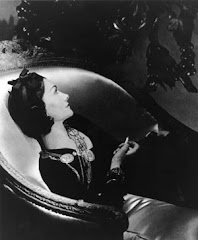
Hadley Freeman has a very interesting piece about being a judge at Graduate Fashion week.
Her point is that because fashion courses in Britain are based at art schools, designers have a supreme understanding of art and none about commerce, ie how to produce clothes that someone would want to wear. Including the designers themselves:
That brings us back to the question of why British students favour the artistic over the commercial. Marian McLaughlin, head of the international office of the Amsterdam Fashion Institute, is attending the London shows and agrees that undoubtedly British fashion students favour "quirkier designs". "You can really see the difference between them and other nationalities," she says. "Probably it's because of the art-school influence. It does produce interesting clothes, but I don't know whether they get jobs afterwards. All of our students definitely do."
But Marten Andreasson, fashion tutor at the University of Middlesex, disagrees.
"I think that, for the students, it is definitely more important to emphasise the creative because this is the time when they have the freedom to experiment and express themselves," he says. "By the time they get to their graduate show, then they should have decided whether they want to go commercial or be more experimental." But what happens to the ones who want to make collections based on the Holocaust? He makes a tactful shrug. "They probably go off and do MAs ..."
This is another thing that puzzles me. Fashion students say that their work is about "self-expression", but what they make always seems to be an awfully long way away from what they actually wear. There are a lot of pretty printed dresses and German tourist-esque shoes in the audience - almost none on the runways. Sharon Dewar, 29, a student at Heriot-Watt University in Edinburgh, agrees that the delicate, multi-layered black dress she has designed doesn't seem to have much in common with the jeans-and-grey-cardigan combo she is wearing. "That's true. But I design things I aspire to, as opposed to things I actually wear, and it's a designer market I'm aspiring to." So what does she think is more important - being commercial or being experimental? "It's a balance really, isn't it? You want to enjoy making the clothes and other people to enjoy wearing them."
UPDATE Greying Pixie has some trenchant remarks on this in the comments.

6 comments:
It's that time of year again - graduate shows at every turn and journalists bemoaning the 'unwearability' of this year's collections.
I think Hadley Freeman should do her research instead of resorting to catty remarks regarding what graduate designers do and do not wear. It's difficult to know where to begin to debate her blinkered view of the British art/design school system, (and the fashion trickledown effect) but probably the first and most important point I would like to make is that you can guarantee that behind every big European name there is a UK trained designer. If our design education system is so out of step with the industry, why do so many international students come here to be trained? The reason that graduates do not get jobs has nothing to do with their training, but with the fact that there are so few jobs to go to in the UK. All design graduates get jobs eventually, but not necessarily in design. No on asks this question of history or language graduates, but for some reason design has to answer to so many nit picking questions.
To point out that a graduate does not wear his or her own designs is infantile and irrelevant and I wonder why she has been allowed to write on such a subject. A well trained designer should be able to address and meet any design brief creatively and practically without the need to sign up to the lifestyle for which it is being provided.
The graduate show of a design student is often their last chance to be as creatively expressive and to research a concept acadmically and soundly over an extended period of time with the freedom and tutorial guidance allowed within an academic institution. It is this explosion of creativity that gives them the momentum to carry them through their first few years in the industry. A well trained design student leaves college like a bullet out of gun.
I expect she's been allowed to write about it because she's the Guardian's deputy fashion editor.
Fashion journalists - now that's another of my soapboxes!
Actually, most of todays Haute Couture is unwearable - and nobody seems to mind.
I love Gallianos designs, but even if I had the neccessary money, I wouldn't consider leaving the house in one of those dresses. Not that I could if I'd wear the matching shoes.
Greying Pixie - couldn't agree more. These collections appear to be more about powerful statements, creative end products after years of academic discipline. Looking beyond the wearability aspects to the concepts and what the designer is trying to say, isn't rocket science. This isn't ready to wear, is it? If they are aspirational, well, it goes with the territory. I want to see young designers make us gasp and make us think. Whether they wear their designs, at this stage in their careers, is irrelevant.
Having now read the article in full, I see that it is not about fashion graduates but about the author herself.
Post a Comment